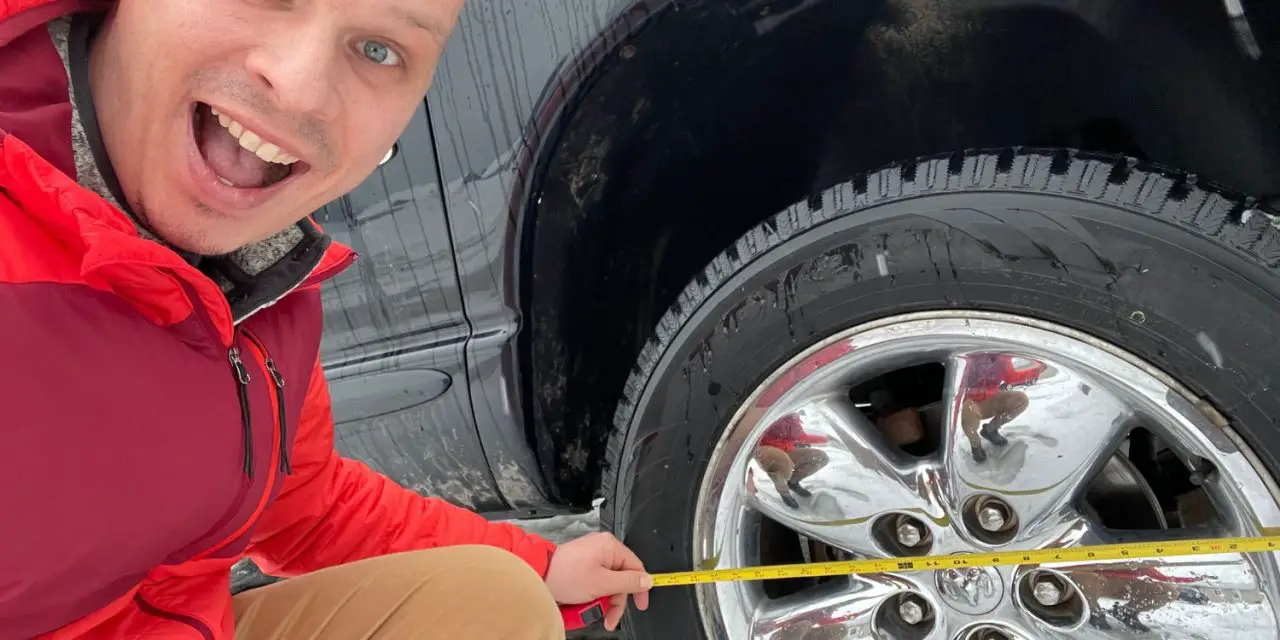If you are anything like me, you probably have been confused a time or two about tire sizing! While the easiest way to find the right tires for your vehicle is just to ask a tire shop, it is most definitely a good idea to understand it yourself as well. Because of that, I put together this complete guide to help you understand what each letter, and number on a tire means, so you can be an educated tire shopper.
The main numbers on a tire, reflect its sizing designation! This consists of three numbers, a slash, two numbers, an “R” and then two numbers after that. For example, it will look something like this 225/65/R17. The 225 stands for the width of the tire, the 65 stands for the aspect ratio of the sidewall, the “R” is the construction type, and the 17 stands for the wheel diameter.
Let’s talk a little bit more about each of these items, so you can fully understand what they mean, and the implications behind them.

1. 225/65R17 – Width

The first number you will find on your tire’s sidewall is its width. This is measured in millimeters, and is a set measurement (unlike the aspect ratio we will talk about later). Tire widths can vary greatly, all the way from thin 125 millimeter tires and below, up to 355 millimeter and above. That said, most passenger tires are generally between 215 millimeters and 255 millimeters in width (of course there are other tires thicker, and thinner than this).
Wider tires are perfect to get additional grip, and you will generally find them on sports cars that are meant for track purposes (or just fun on backroads), where you won’t want to be slipping around on the pavement. You will also find wider tires on off-road vehicles and trucks, where you need the additional tread so that you don’t sink down into sand and mud easily. That said, thicker tires means more rolling resistance, and will cause your gas mileage to take a hit.
Thinner tires may not be great for performance, however they are lighter, and have less overall rolling resistance. This means less road noise, and better gas mileage. However, the thinner you go, the less you can count on them helping you to brake, or keep you from things like hydroplaning and more.
Most vehicle manufacturers like to strike a balance between performance, and gas mileage with their tire choices. The result of this is having a width that is somewhere in the middle.
2. 225/65R17 – Aspect Ratio

The aspect ratio of a tire size is a relative measurement to the width of the tire from the section above to the sidewall. The “65” in the example we are talking about means that the sidewall of a tire is 65% of the overall width of the tire (65% of the 225 millimeters is 146 millimeters). This measurement is generally where most people get lost, and for good reason, as it is quite confusing.
Generally speaking, you will find an aspect ratio of 65% or so on most passenger tires, however there are of course, exceptions!
You will find higher aspect ratios (taller sidewall) on off-roading vehicles, having the additional sidewall gives these vehicles that ability to “air-down” their tires to give more contact to the ground. This additional sidewall also means there is more air in the tires, which is able to absorb more impact (meaning less strain on the suspension).
On the other hand, you will find lower aspect ratios (generally under 50%) on low performance vehicles. Lower profile tires mean more rigid tires, which can give a vehicle more responsive steering. These vehicles generally are regarded as “cooler vehicles”, and many manufacturers are starting to add lower profile tires to more standard vehicles, however, the trade off is ride quality, as there is less give in these lower profile tires, meaning you either have a rougher ride, or you have to have better (and more expensive) suspension to account for this.
3. 225/65R17 – Construction Type
While I always thought that the “R” in front of the wheel diameter stood for “Rim”, I was surprised to find that this is in fact the construction method of the tire. The most common type in modern days is a radial tire, and in the example we are reviewing, that would represent the “R”.
The three different types of tires are radial, bias and belted-bias:
- Radial Tires – These tires are built with metal chords that are arranged at 90 degrees towards the direction of the tire you own.
- Bias Tires – These tires utilize overlapping tire plies at 30 all the way up to a 45 degree angle.
- Belted-bias – These utilize two layers of material including nylon cords, and steel belts.
All of this said, radial tires are by far the most common tires on the road, and most people will never see or use a bias or belted-bias tire in their life.
4. 225/65R17 – Wheel Diameter

The final set of numbers on your tire’s sidewall is the wheel diameter. This diameter is measured in inches (yes, we are mixing imperial and metric measurements on tires). In the example of 225/65R17, we are working with a 17″ wheel! This will be the diameter you will want to make sure to match your wheel to, as you won’t be able to fit any other diameter wheel on this size tire.
In conjunction with the aspect ratio we talked about earlier, wheel diameters have been growing over the years, as people think the larger wheel diameter makes a vehicle look better. While that may be true, the larger wheel diameters do play a role in ride qualities becoming rougher, and causing prices of vehicles to go up, as we need more complicated air suspension setups to offset the fact that tires don’t have as much give anymore.
- CAN YOU PUT TIRES ON BACKWARDS? THE ANSWER MIGHT SURPRISE YOU
- ONCE A MONTH: HOW OFTEN SHOULD YOU AIR UP YOUR CAR’S TIRES?
- WHEEL VS TIRE: WHAT IS THE DIFFERENCE BETWEEN THE TWO?
What do the letters in front of the numbers mean?
Most tires on the road today will start with a letter before the sizing information we talked about above. They will come in the form of a C, LT, P, ST, T, or you might find no letter at all. These explain exactly what type of tire you are working with, and will help you understand if the tire is meant for the type of vehicle you own.
You will never want to mix tire types with vehicles that they are not meant for, as it is possible to cause the tire to blow out at the worst, or give you a rougher ride than you are hoping for. While you may find identically sized tires in each of these categories, that isn’t the only thing you need to think about, as these designations matter too.
| Designation | Meaning | Explanation |
|---|---|---|
| C | Commercial | Durable, more tread, lower ride quality |
| LT | Light Truck | Higher payload and towing, better ride quality than commercial |
| P | Passenger Metric | General use tires for consumer vehicles |
| ST | Special Tire | Trailer, camper, boat, etc trailer tires |
| T | Temporary | Spare tires, donut tires |
| NO LETTER | Euro Metric | General use tires, better capacity than “P” |
Conclusion
So there you have it! That is everything you need to know about how the sizing of tires works! Next time you glance at tires, and see something like 225/65R17, you will know that the 225 stands for the width of the tire, the 65 stands for the aspect ratio (sidewall), the R stands for Radial, and the 17 is the size of the wheel that the tire is meant for.





